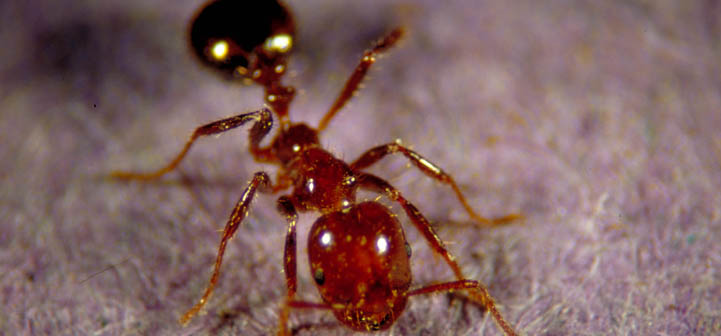FA Youth Home > List of Exercises > Be An Ant Scientist
Activity: Be An Ant Scientist!
Overview
Trap ants using attractants (foods) to see what species you find in your area. Learn about dichotomous keys and how they are used to identify insects. Determine whether the ants are harmful or beneficial. Learn to use a dichotomous key to identify a species of ant.
Safety Tip
- Fire ants are likely to be attracted to the bait cups, so be careful when inspecting cups to minimize the possibility of stings. If you know you are allergic to fire ants, do not do this exercise.
- First aid for fire ant stings: Commercially available sting medications will help. Washing stings with soap and water will clean the area and help reduce the chances of secondary infection. Some individuals may experience allergic reactions to the bites. Refer to the Fire Ant Project Fact Sheet, Medical Problems Associated with the Imported Fire Ant, for more information on medical issues.
- If you are stung, do not scratch the sting or rupture the pustule that might occur at the sting site because secondary infections may occur. The pustule is a normal result of a fire ant sting and is sterile unless ruptured.
Objective
Become familiar with many types of ants in the environment and determine whether they are harmful or beneficial. They will learn to use a dichotomous key to identify a species of ant.
Materials
- Fire Ant Project Fact Sheet 028, Collecting and Maintaining Colonies of Red Imported Fire Ants for Study
- Small (1 oz) condiment cups with snap-on lids
- Canned tuna, potato chips, dry cat food, Vienna sausage, etc., to use as bait
- Hand lens or other magnifying instrument
- Permanent markers
- Fire Ant Project Fact Sheet, Texas Pest Ant Identification Illustrated Key
- Soap
- Sting medications
- Paper
- Pen or pencil
- Be an Ant Detective Game Picture Cards
Activity
- Familiarize yourselves with the Texas Pest Ant Identification — An Illustrated Key fact sheet (FAPFS010). (See link above in Materials.)
- Select an ant attractant (food) and place a small amount of it on the inside of the cup lid.
- Repeat this until you have about six cup lids with food. You can use different foods on different lids if you want.
- Go outdoors and place the lids, food side up, anywhere you wish.
- Leave the lids undisturbed for 30 minutes.
- After 30 minutes, snap the condiment cups down onto the lids and take the captured ants inside.
- Kill the ants collected by placing the cups in the freezer overnight or by placing them in alcohol.
- Use hand-held magnifying glasses or other magnifying instruments to take a closer look at your ants.
- Using the Pest Ant Key and Ant Detective Game Picture Cards, try to identify the ants as best as possible. This exercise will work best in Texas, but you should be able to get some idea of which ants you have in other areas.
- Note that all ants are extremely prolific and killing a few will not harm the overall population of ants. Scientists generally agree that ants cannot feel pain and freezing them is the best way to observe them for study.
Wrap-up
- Were the ants trapped among the list of competitors of fire ants? How many different types of ants were collected?
- Compare the number of trapped ant species to what was learned about fire ants. Does the presence of these species affect the number of fire ants found? Were there many fire ants and only a few others (competitors), or many competitors and few fire ants?
- Write a short story about a day in the life of an ant.
Additional Information for Instructors
-
You may want to refer to the original KIDzANTS Teacher Manual, which was included in the original release of the KIDzANTS Red Imported Fire Ant Youth module developed by the Texas A&M AgriLife Extension Service.
| << Previous: What Do You Like to Eat? | List of Exercises | >> Next Exercise: Be An Ant Detective |
